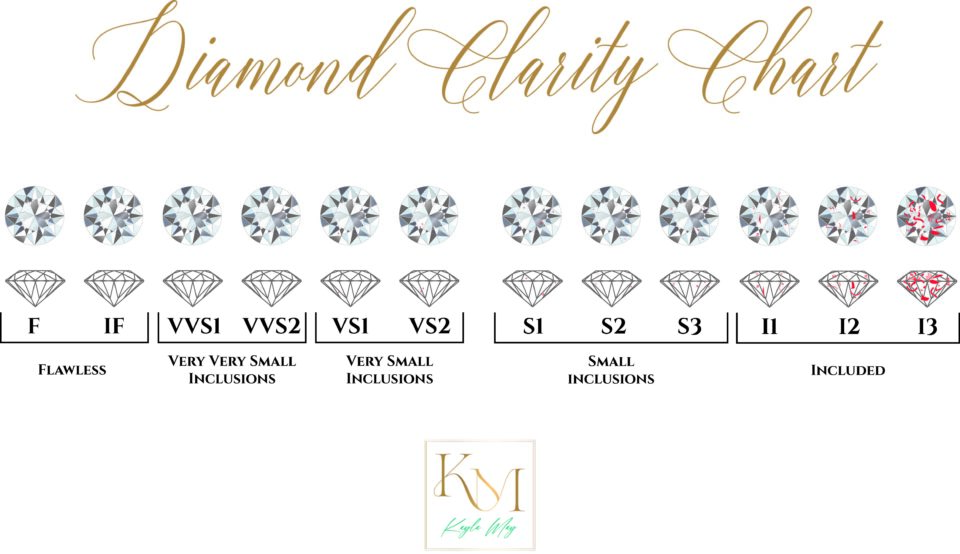- by Kaylamaydesigns
- May 24, 2023
- Diamond Education

Key Takeaway:
- Diamond clarity grade is an important factor in determining a diamond’s value: The clarity grade assesses the number, size, and location of imperfections, which can affect the diamond’s appearance and brilliance.
- The GIA clarity scale is the most commonly used chart to evaluate diamond clarity: The scale measures clarity on a range from Flawless to Included, with 6 categories and 11 grading levels. The characteristics of each clarity grade can affect a diamond’s value.
- VS2 and SI1 are the most popular clarity grades for value and quality: While higher grades like VVS or IF may have fewer imperfections, the cost is often significantly higher. Buyers should consider their budget and priorities when choosing a clarity grade.
Diamond Clarity Grade and its Importance
Diamond Clarity Grade: Why It Matters
The clarity grade of diamonds is a crucial factor to consider when purchasing diamond jewelry. A diamond’s clarity grade refers to the blemishes and inclusions present on its surface and inside. The higher the clarity grade, the less visible these imperfections are, and the more valuable the diamond is.
When considering the diamond clarity grade and its importance, it is essential to note that blemishes or inclusions may affect the diamond’s brilliance and sparkle. This is because light passing through the diamond may be obstructed or refracted. A high clarity grade results in a more sparkling and brilliant diamond, making it a more desirable purchase.
Moreover, a diamond’s clarity grade influences its appraisal value. In the diamond industry, slight differences in clarity can affect the price significantly. A diamond with a higher clarity grade will have a higher value and sell for more than a diamond with a lower clarity grade.
Pro Tip: Before purchasing a diamond, get a diamond grading report from a reputable gemological laboratory, such as GIA, AGS, or EGL. The diamond grading report will include the clarity grade, among other vital factors, and will help ensure that you make an informed decision.
Diamond Clarity Chart Explained
A Clear Understanding of Diamond Clarity Chart
A diamond clarity chart is an essential tool when selecting a diamond. It allows you to understand the grading that a diamond has undergone to determine its clarity. The chart grades diamond clarity from “Flawless” to “Included.” The clearer the diamond, the more valuable it is. The chart has various grades that each indicate different levels of clarity.
The table below showcases the diamond clarity chart explained with actual data:
| Diamond Clarity Grades | Description |
|---|---|
| Flawless (FL) | No internal or external blemishes and inclusions. |
| Internally Flawless (IF) | No internal blemishes with small surface blemishes. |
| Very Very Slightly Included (VVS) | Inclusions are not visible to the naked eye. |
| Included (I) | Obvious inclusions that can affect transparency and brilliance of a stone. |
Interestingly, diamond clarity chart gradings are determined using a 10x lens magnification by highly skilled professionals. It helps to identify the diamond’s beauty and value. An untrained eye may not see such inclusions, but the diamond clarity chart can document them.
My friend recently bought a diamond that came with a clarity chart indicating that it was internally flawless. Upon closer inspection with a magnifying lens, he realized that there were minor black spots commonly referred to as carbon spots. He confronted the dealer and had the diamond reassessed. It turned out that it was only a Very Slightly Included (VS) instead of Internally Flawless (IF). This situation highlights the importance of using a diamond clarity chart and the need to research before buying a diamond.
Understanding Eye-Clean Diamonds
When evaluating a diamond’s clarity, it’s important to understand what it means for a diamond to be “eye-clean.” This refers to a diamond that appears to be free of any inclusions or blemishes when viewed with the naked eye. To achieve this level of clarity, diamonds should be graded as VS2 or higher. However, it’s important to note that the location of any inclusions within the diamond can greatly impact its appearance to the naked eye. Understanding the concept of eye-clean diamonds is crucial when making a decision on which diamond to purchase. Don’t miss out on the opportunity to own a stunning eye-clean diamond for your next special occasion.
Best Clarity Grades to Consider
In the world of diamonds, selecting the “finest clarity standards” is crucial to ensure your diamond is of high-quality. A diamond with a higher clarity rating has fewer inclusions and blemishes, making it more valuable and rare. Below is a table displaying the best clarity grades to consider when purchasing a diamond. The grades range from Flawless to Included, with Flawless being the rarest and most valuable. When selecting a diamond, it is always recommended to aim for a grade of Very Slightly Included or better for the most beautiful and high-quality diamond. In addition to the clarity grade, it is always a good idea to seek the advice of a reputable diamond expert to ensure you make the best purchase.
| Clarity Grade | Description |
|---|---|
| Flawless | No inclusions or blemishes visible under 10x magnification. |
| Internally Flawless | No inclusions, only blemishes visible under 10x magnification. |
| Very, Very Slightly Included (VVS1 and VVS2) | Inclusions extremely difficult to see under 10x magnification. |
| Very Slightly Included (VS1 and VS2) | Inclusions difficult to see under 10x magnification. |
| Slightly Included (SI1 and SI2) | Inclusions visible under 10x magnification. |
| Included (I1, I2, and I3) | Inclusions visible to the naked eye. |
One important consideration when selecting a diamond is the location of the inclusions. Inclusions located at the edges or corners of the diamond could impact its durability, and therefore, are worth avoiding. It is also important to note that certain cuts can hide inclusions better than others.
A friend of mine once purchased a diamond with a lower clarity rating to save money, but upon closer inspection, the inclusions were visible to the naked eye. She later regretted her decision and wished she had invested in a diamond with a higher clarity grade. Learn from her experience and aim for the best clarity grades to consider when selecting a diamond.
Final Thoughts
As we conclude our discussion on the Diamond Clarity Chart, it is crucial to note that while it provides a useful guide for evaluating diamonds, it should not be the sole factor in your decision-making process. It is essential to consider other factors such as the diamond’s cut and color, as they also contribute significantly to its overall appearance and value. Additionally, keep in mind that while a diamond’s clarity grade is important, it is ultimately subjective and can vary between different laboratories and graders.
Fun fact: The concept of the Diamond Clarity Chart was introduced by the Gemological Institute of America (GIA) in the 1950s and has since become the standard in the diamond industry.
Some Fast Facts About Diamond Clarity Chart:
- ✅ There are 6 clarity categories with a total of 11 clarity grades. (Source: Team Research)
- ✅ The FL (Flawless) clarity grade is incredibly rare and expensive. (Source: Team Research)
- ✅ The VS1 and VS2 (Very Slightly Included) clarity grades are the most often searched on Rare Carat. (Source: Team Research)
- ✅ Inclusions in the I1, I2, and I3 (Included) clarity grades are usually visible to the naked eye and negatively impact the diamond’s appearance. (Source: Team Research)
- ✅ VS2 and SI1 clarity grades are considered the holy grail of diamond clarity and offer the best value for money. (Source: Team Research)
FAQs about Diamond Clarity Chart
What is the GIA clarity scale?
The GIA clarity scale is a system used to grade the clarity of diamonds. It uses 6 categories with a total of 11 clarity grades, ranging from Flawless (FL) to Included (I1, I2 & I3).
What does it mean for a diamond to be eye clean?
When a diamond is considered eye clean, it means that any inclusions present can’t be seen by the naked eye. These inclusions may be visible under magnification, but they don’t affect the diamond’s appearance or brilliance when viewed without magnification.
What are visible inclusions and how do they affect a diamond’s appearance?
Visible inclusions are imperfections in a diamond that can be seen by the naked eye. They can negatively impact the way light travels through the stone, reducing its fire and brilliance and making it appear dull or cloudy.
What is fire in diamond clarity?
Fire in diamond clarity refers to the way a diamond reflects light and creates rainbow-colored flashes. It’s a key aspect of a diamond’s appearance and can be affected by the presence of inclusions or other imperfections.
What is the holy grail of diamond clarity?
The holy grail of diamond clarity is considered to be the VS2 and SI1 grades, which are highly likely to offer a gorgeous, eye-clean diamond without the high cost associated with Flawless or Internally Flawless stones.
How does carat size affect diamond clarity?
Generally speaking, larger diamonds tend to have more visible inclusions than smaller ones, as imperfections will be easier to spot on a larger surface area. However, the impact of size on clarity will depend on the other factors involved, such as the diamond’s cut and the nature of the inclusions present.
Does the number of inclusions affect diamond clarity?
Yes, the number of inclusions does play a role in diamond clarity grading. Generally speaking, the more inclusions there are, the lower the clarity grade will be. However, the size and location of inclusions can also impact the final clarity grade, so the number alone isn’t the only factor to consider.
